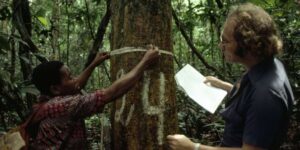Interview Techniques explained

Interview techniques: this article explains the concept of interview techniques in a practical way. The article starts with the definition of the term, followed by a general explanation and a summary of the different interview techniques used by researchers and students working on their thesis, for example. You will also find information about which technique best suits each type of research. Enjoy reading!
What are interview techniques?
In the world of research, conducting successful interviews plays an essential role in obtaining valuable information and insights.
Whether you are a student doing research for a thesis or a researcher collecting data for a science project, mastering effective interviewing techniques is invaluable.
Intended as a practical guide, this article provides insights and tips on interviewing techniques that are specifically aimed at research students, but are also of value to anyone looking to improve their interviewing skills.
An example of such a situation is found in Mark’s story:
Mark is a dedicated student working on his research project on sustainable energy. Mark spent months collecting data, conducting interviews and conducting analysis to thoroughly substantiate his research.
However, when the time came to present his findings at an important research interview, Mark found himself struggling to communicate his ideas clearly and convincingly. Despite his deep knowledge and passion for the subject, Mark lacked the proper interviewing techniques to confidently present his research.
He struggled with structuring his answers, asking the right questions and communicating his findings effectively. As a result, he was unable to exploit the full potential of his research and missed the opportunity to increase his impact.
Definition and general information
Interviews can be defined as structured conversations between an interviewer and a respondent to gather relevant information for research purposes.
The purpose of a research interview is to gain in-depth insights, collect opinions, and understand respondents‘ perspectives and experiences.
These interviews are invaluable in gathering qualitative data that can strengthen and enrich the research.
Mastering interviewing techniques is critical, as it enables researchers to ask effective questions, apply proper listening skills, and build trust with respondents.
Through the use of targeted interviewing techniques, researchers can obtain in-depth and valuable information, resulting in a sophisticated and reliable research process.
Interview techniques and interview skills
The following sections cover various interview techniques, such as drafting open-ended questions, active listening, creating a relaxed atmosphere, and analyzing the information gathered.
By understanding and applying these essential aspects of interviewing techniques, research students and anyone else who’s interested will be able to strengthen their interviewing skills and be more successful in collecting valuable data for their research.

Figure 1 – Types of Interview Techniques
Asking open-ended questions
Asking open-ended questions is an important technique for obtaining in-depth and detailed information during a research interview.
By asking questions that begin with “what,” “how,” or “why,” you encourage the respondent to provide comprehensive answers and share their perspectives and experiences.
Active listening
Active listening is essential to listen actively during a research interview. Give respondents your full attention, take notes, and show that you appreciate their answers. By listening carefully, you can ask follow-up questions and dig deeper into points of interest, leading to a more enriching discussion.
Creating a relaxed atmosphere
It is important to create a relaxed and confidential atmosphere during the interview. Put the respondents at ease by adopting a friendly and respectful attitude. Show interest in their points of view and approach the conversation as a valuable exchange of knowledge and insight.
Interview techniques: analyzing collected information
After conducting the interview, it is time to analyze the information collected. Identify patterns, themes, and key insights emerging from the answers. This analysis forms the basis for further conclusions and findings in the study.
By mastering these interviewing techniques, research students and other interested parties can improve their skills and gain valuable information.
Conducting research interviews effectively contributes to the reliability and depth of the research and can lead to new insights and discoveries.
Research Methods For Business Students Course
A-Z guide to writing a rockstar Research Paper with a bulletproof Research Methodology!
Interview techniques and tips
Below is an overview of different types of interviews commonly used in research, with brief explanations and a short example for each type:
In-depth interviews
An interview in which the researcher gathers extensive and detailed information by delving deeply into the topic. The aim is to gain an in-depth understanding of the respondent’s experiences, views and perspectives.
Example: An in-depth interview can be used to explore veterans’ experiences and challenges in their reintegration into society. The interviewer could ask the respondent questions about their military service, the transition to civilian life, and any psychological and emotional challenges.
- Suitable for research aimed at gaining in-depth insights and understanding of individuals’ experiences, beliefs and perspectives
- Suitable when the researcher has the time and resources to conduct extensive interviews and delve deeply into specific topics
- Ideal for exploring complex topics with an emphasis on individual experiences, such as the impact of long-term illness on quality of life
Structured interviews
An interview where questions are predetermined and asked in a set order. The questionnaire remains consistent for all respondents, allowing for comparable data to be collected.
Example: A structured interview can be used to collect demographic information such as age, gender, and education level of the respondents in a consumer behavior survey.
- Suitable for research where it is important to collect comparable standardized data from respondents
- Effective when there is a need for objective and measurable information, such as demographics, behaviors or opinions on a scale
- Useful when there is a large number of respondents and there is a need for efficiency in data collection
Semi-structured interviews
An interview that offers flexibility to both the interviewer and the respondent. While there is a basic set of questions, the order and depth of the questions may vary based on the respondent’s answers.
Example: A semi-structured interview can be used to explore teachers’ experiences and opinions on the use of technology in the classroom, leaving room for specific examples and personal insights.
- Fits well with research that requires flexibility and depth, such as exploring personal experiences, attitudes and perceptions
- Suitable for research in which the researcher wants to retain some structure, but also wants to provide space for respondents to put forward their own perspectives
- Ideal when there is a need for deepening and clarification of certain themes or when variation can occur between respondents
Interview techniques: unstructured interviews
An interview where there are no predetermined questions. The conversation follows a free form and the interviewer encourages the respondent to speak freely and share ideas and experiences.
Example: An unstructured interview can be used to explore politicians’ personal beliefs and motives, emphasizing open discussion and deep reflection.
- Fits well with explorative research with an emphasis on openness, free expression and unexpected insights
- Suitable when the researcher wants flexibility and freedom to delve deeply into topics indicated by the respondent
- Ideal for research in which the researcher wants to be guided by the respondents to discover new perspectives and ideas
Focus groups
A group interview where a moderator leads a discussion with a small group of participants. The focus group offers the opportunity to collect different perspectives and to stimulate interaction between participants.
Example: A focus group can be used to explore opinions and perceptions about healthcare services by bringing together a group of patients and having them talk about their experiences and suggestions for improvement.
- Suitable for research where interaction and dynamics between participants are important, such as exploring social norms, group dynamics or shared experiences
- Useful when there is a need for diverse perspectives and for comparing opinions and views within a group
- Ideal for research where discussion and exchange of ideas between participants can provide valuable insights, such as product development or policy making
The right type of interview depends on the research questions, the purpose of the research and the nature of the data to be collected.
Now it’s your turn
What do you think? Do you recognize the explanation of interview techniques? Have you ever conducted an interview or were you interviewed yourself? If so, what techniques were used then? What do you find most difficult about conducting an interview? What tips can you share for students preparing to conduct a research interview? Do you have other tips or comments?
Share your experience and knowledge in the comments box below.
More information
- Barick, R. (2021). Research Methods For Business Students. Retrieved 02/16/2024 from Udemy.
- Cannell, C. F., Miller, P. V., & Oksenberg, L. (1981). Research on interviewing techniques. Sociological methodology, 12, 389-437.
- McGehee, N. G. (2012). Interview techniques. In Handbook of research methods in tourism. Edward Elgar Publishing.
- Opdenakker, R. (2006). Advantages and disadvantages of four interview techniques in qualitative research. In Forum qualitative sozialforschung/forum: Qualitative social research (Vol. 7, No. 4).
How to cite this article:
Janse, B. (2023). Interview Techniques. Retrieved [insert date] from Toolshero: https://www.toolshero.com/research/interview-techniques/
Original publication date: 07/31/2023 | Last update: 01/02/2024
Add a link to this page on your website:
<a href=”https://www.toolshero.com/research/interview-techniques/”>Toolshero: Interview Techniques</a>












